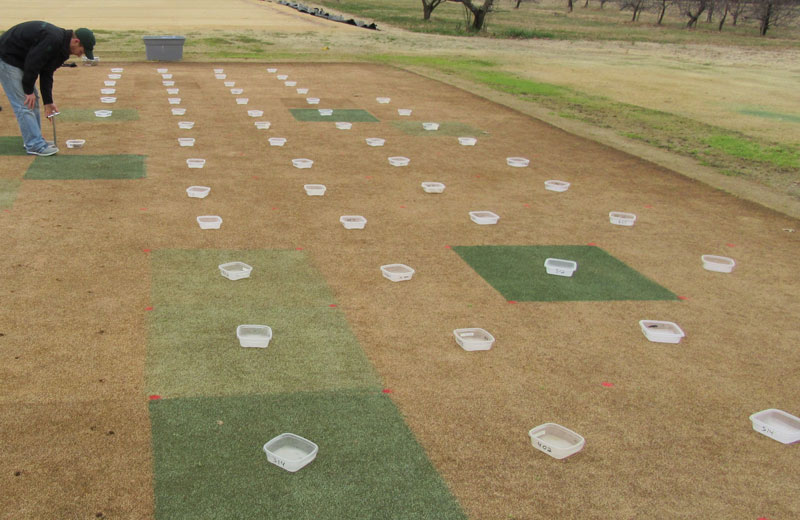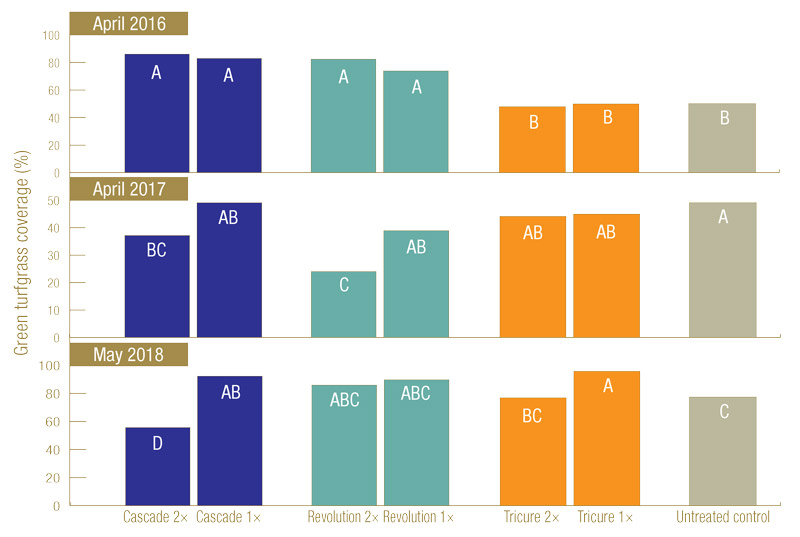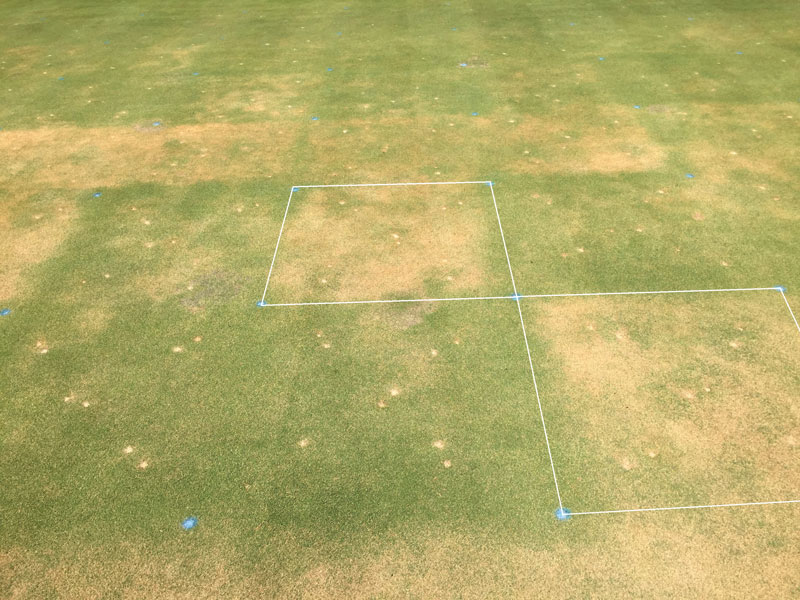
Figure 1. This research aimed to determine whether a late-season wetting agent application could reduce winter injury and soil hydrophobicity and increase soil volumetric water content on ultradwarf bermudagrass putting greens. In this photo, soil cores are being pulled to test for hydrophobicity. Photo by Daniel O’Brien
Editor’s note: This research was partially funded by GCSAA through a grant from the Environmental Institute for Golf, and by the United States Golf Association.
Ultradwarf bermudagrasses have become a more popular choice for putting greens in the transition zone over the past decade. A significant management challenge with these greens is winter survival and spring recovery. Plant tissue desiccation and low-temperature exposure are two common causes of winter injury to ultradwarf bermudagrass putting greens. Unlike exposure to low temperatures, winter tissue desiccation can occur even under mild weather conditions and may be worse when soils are hydrophobic.
Hydrophobic root zones can lead to the appearance of irregularly shaped areas of desiccated turf that are commonly referred to as localized dry spot (2). Wetting agents have become a common tool that superintendents use to mitigate damage from localized dry spot, but the beneficial effects of wetting agents are short-lived, as they are degraded in biologically active soils. Therefore, wetting agents are commonly applied to putting greens at routine intervals throughout the spring and summer months.
Because wetting agents do not typically cure the underlying cause of soil hydrophobicity, those conditions may return during winter and could result in turfgrass desiccation. This may go unnoticed, as visual symptoms of localized dry spot may not be evident if an ultradwarf bermudagrass green is fully dormant.
Although wetting agents have been documented to reduce soil water repellency on sand-based putting greens (6), minimal research has been conducted regarding the effects of applying wetting agents to dormant grasses for the purpose of combating winter turfgrass desiccation (3, 4). It may also be possible that reduced soil microbial activity during winter months increases wetting agent longevity in the soil. The overall objective of the present work was to determine whether a late-season wetting agent application could reduce winter injury and soil hydrophobicity and increase soil volumetric water content on ultradwarf bermudagrass putting greens (Figure 2, below).
Materials and methods
Trials were conducted at the University of Arkansas in Fayetteville, where three popular wetting agents were applied to a sand-based TifEagle putting green in mid-December over three consecutive growing seasons (2015-2017), and spring green-up, soil volumetric water content, and water drop penetration time tests were subsequently evaluated.
Treatments were applied at both the labeled rates (1×) and twice the labeled rates (2×), and included Cascade Plus (Precision Laboratories), Revolution (Aquatrols), TriCure (Mitchell Products) and an untreated control. Revolution and TriCure were applied at 6 and 12 fluid ounces/1,000 square feet (19.1 and 38.2 liters/hectare), and Cascade Plus was applied at 8 and 16 fluid ounces/1,000 square feet (25.5 and 50.9 liters/hectare). Immediately after wetting agent applications, 0.25 inch (6.35 millimeters) of irrigation was applied to the entire area to facilitate movement of the product into the root zone. A more complete description of all methods has been reported previously (4).
Results and discussion
During the spring green-up period of each season, green turfgrass coverage of experimental plots was monitored using digital image analysis (8). Each of the wetting agents tested increased green turfgrass coverage compared with the untreated control in at least one trial season.
Click on image to enlarge:

Figure 2. Effect of late-fall wetting agent application on green turfgrass coverage of an ultradwarf bermudagrass putting green in Fayetteville, Ark., from 2016 to 2018.
In 2016, Cascade Plus and Revolution increased spring green-up compared with the untreated control (Figures 2, 3), whereas in 2018, every treatment increased spring green-up compared with the untreated control (Figure 2). The lack of wetting agent effect in 2017 may have been caused by increased rainfall, most notably in April 2017 (Table 1).
Soil volumetric water content was evaluated using a TDR 300 (Spectrum Technologies) equipped with 0.6-inch (1.5-centimeter) rods. No treatment effect was observed for soil volumetric water content in any year (data not shown). It was interesting to note, however, that root-zone moisture content was 7% higher in April 2017 than in April 2016. Wetter conditions in 2017 may help explain why wetting agent applications had no effect on green turfgrass coverage in 2017.
Root-zone water repellency was quantified using water drop penetration time (5, 7). Soil cores were removed two weeks after wetting agent application and again in April of the following spring. Water drop penetration time tests were performed by placing a 36.0-microliter droplet of deionized water on the cores at depths of 0.4, 0.8, 1.2, 1.6 and 2.0 inches (1, 2, 3, 4 and 5 centimeters) (measured from the top of the soil core) and recording the time in seconds it took for the droplet to penetrate the surface of the soil core. The length of time the water droplet remained on the soil core before being absorbed is indicative of the degree of hydrophobicity present in the soil at each depth tested. Essentially, less hydrophobic soils will absorb the water faster and have a shorter water drop penetration time.
In general, water repellency was only detected in the top 0.4 inch (1.0 centimeter) of the soil profile. Because treatment effects were most pronounced in this top layer of the soil profile, discussion will be limited to this depth. It is interesting to note that root-zone water repellency tended to decrease from January to April within a given year. This could be due to cool, wet conditions that perhaps resulted in a net decrease in waxy coatings on sand particles.
Both Revolution and Cascade Plus reduced water drop penetration time in January and April of 2016 and 2017, indicating an ability to persist in the soil through winter (Table 2). TriCure was the most inconsistent at reducing water drop penetration time compared with the untreated control, but in 2018, the 1× rate of TriCure did reduce water drop penetration time in both January and April (Table 2).
Interestingly, water drop penetration time was reduced from 62 to 36 seconds from April 2016 to April 2017 when only the 0.4-inch soil depth was considered, exclusive of treatments. The shorter water drop penetration time in April 2017 indicates the soil was less hydrophobic than it was in April 2016. Increased precipitation, most notably in April 2017 (Table 1), likely reduced hydrophobicity, and that reduction may explain the lack of wetting agent effect on green turfgrass coverage in 2017.
Conclusions
This research demonstrates that a late-fall application of a wetting agent can provide added protection to ultradwarf bermudagrasses from winter injury associated with desiccation. The benefits of a late-fall wetting agent application appear to be more pronounced in years with drier winter conditions, suggesting that protection may be even more valuable for a non-irrigated golf course than for a golf course with the ability to irrigate during winter. However, research involving targeted soil moisture conditions during winter would be helpful to define this approach.

Figure 3. Delayed spring green-up of ultradwarf bermudagrass in untreated control plots in Fayetteville, Ark., on April 26, 2016. Photo by Eric DeBoer
Although wetting agents did not affect soil volumetric water content in this trial, wetting agents did reduce water drop penetration time in the top 0.4 inch of the soil profile, and, in multiple seasons, that benefit persisted for several months.
Throughout the trial, applying the wetting agent at twice the labeled rate never increased green turf coverage compared with the labeled rate of the same product. This suggests that, for a one-time late-fall application, the labeled rate is sufficient as an insurance policy if dry weather were to persist throughout the winter. It is currently unclear whether wetting agents should be reapplied to a dormant ultradwarf bermudagrass putting green through winter, similar to what is done during the hotter months of the year. Because the breakdown of the products is a function of soil microbial activity, the effects of the wetting agent may persist much longer during the cooler months.
Because a wide variety of wetting agents is currently on the market, future research with a broader array of products would be beneficial to increase our knowledge of how different wetting agents persist in the soil through winter. It is important to note, however, that wetting agents have been shown to persist in the soil of a creeping bentgrass research putting green through winter in Minnesota (1), as well as in our research on ultradwarf bermudagrasses in Arkansas (3, 4).
The results from these trials should further assist golf course superintendents in decision-making for minimizing winter injury of bermudagrass putting greens. Remember, “out of sight, out of mind” should not apply to winter management of localized dry spot. Just because the symptoms of localized dry spot may not be apparent on dormant turf does not mean they are not present. An early-winter wetting agent application will help assure spring green-up is not delayed because the root zone is dry.
Funding
The authors wish to express their sincere gratitude to GCSAA and the EIFG as well as the United States Golf Association for providing the financial assistance to support this research.
Acknowledgments
Special thanks to John McCalla and Daniel O’Brien for assistance with research.
The research says ...
- A late-fall application of a wetting agent can help protect ultradwarf bermudagrasses from winter injury from desiccation.
- These applications may be more valuable for golf courses that are not irrigated in winter.
- Wetting agents reduced water drop penetration time in the top 0.4 inch of the soil profile; that benefit persisted for several months.
- An early-winter wetting agent application will help prevent delayed spring green-up.
Literature cited
- Bauer, S.J., M.J. Cavanaugh and B.P. Horgan. 2017. Wetting agent influence on putting green surface firmness. International Turfgrass Society Research Journal 13:1-5.
- Beard, J.B., and H. Beard. 2005. Beard’s turfgrass encyclopedia for golf courses, grounds, lawns, sports fields. Michigan State University Press, East Lansing, Mich.
- DeBoer, E.J., M.D. Richardson, J.H. McCalla and D.E. Karcher. 2019. Reducing ultradwarf bermudagrass putting green winter injury with covers and wetting agents. Crop, Forage & Turfgrass Management 5:190019 (https://doi:10.2134/cftm2019.03.0019).
- DeBoer, E.J., M.D. Richardson, J.H. McCalla and D.E. Karcher. 2020. Effect of late-fall wetting agent application on winter survival of ultradwarf bermudagrass putting greens. Crop, Forage & Turfgrass Management (https://doi.org/10.1002/cft2.20035).
- Kostka, S.J., J.L. Cisar, J.R. Short and S. Mane. 1997. Evaluation of soil surfactants for the management of soil water repellency in turfgrass. International Turfgrass Society Research Journal 8:485-494.
- Leinauer, B., D. Karcher, T. Barrick, Y. Ikemura, H. Hubble and J. Makk. 2007. Water repellency varies with depth and season in sandy rootzones treated with ten wetting agents. Applied Turfgrass Science 4:1-9 (https://doi.org/10.1094/ATS-2007-0221-01-RS).
- Letey, J. 1969. Measurement of contact angle, water drop penetration time, and critical surface tension. In: L.F. DeBano and J. Letey, eds. Proceedings of the Symposium on water-repellent soil. May 6-10, 1968. University of California, Riverside.
- Richardson, M.D., D.E. Karcher and L.C. Purcell. 2001. Quantifying turfgrass cover using digital image analysis. Crop Science 41:1884-1888 (https://doi.org/10.2135/cropsci2001.1884).
Eric J. DeBoer is a program technician and doctoral student, Douglas Karcher is a turfgrass soil specialist and professor, and Michael Richardson is a professor in the Department of Horticulture at the University of Arkansas, Fayetteville, Ark.